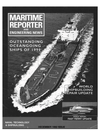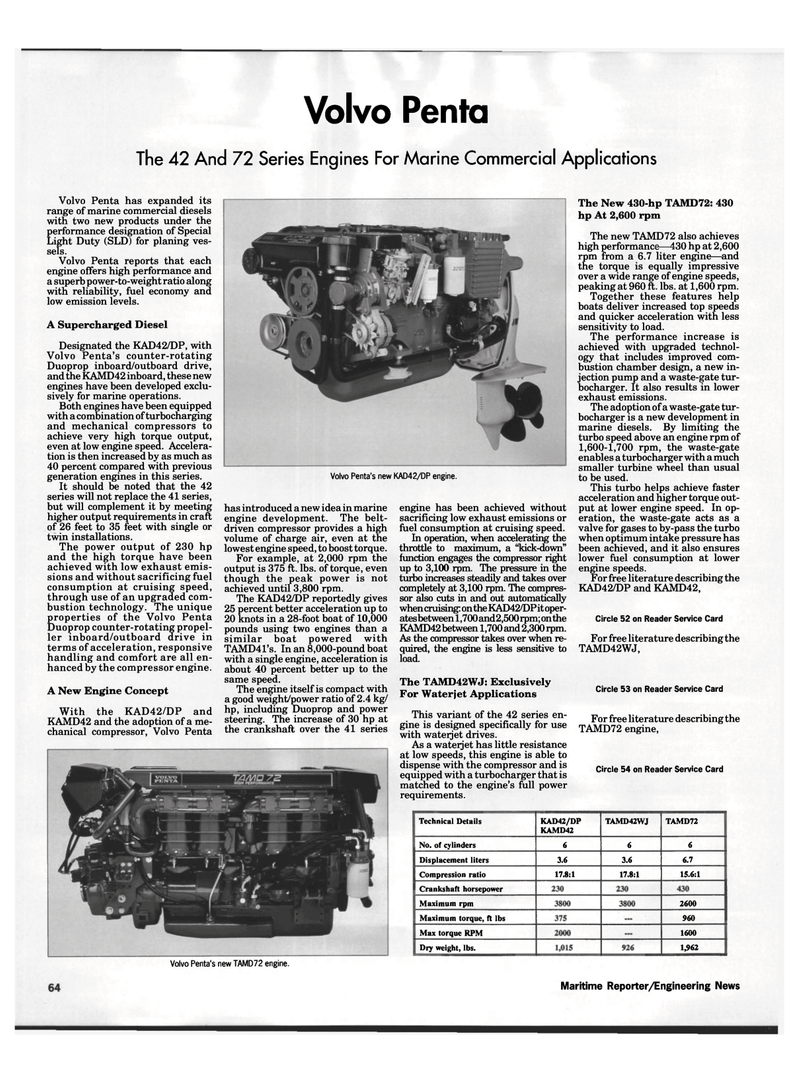
Page 66: of Maritime Reporter Magazine (December 1992)
Read this page in Pdf, Flash or Html5 edition of December 1992 Maritime Reporter Magazine
Volvo Penta
The 42 And 72 Series Engines For Marine Commercial Applications
Technical Details KAD42/DP TAMD42WJ TAMD72
KAMD42
No. of cylinders 6 6 6
Displacement liters 3.6 3.6 6.7
Compression ratio 17.8:1 17.8:1 15.6:1 2600 960 1600 1,962 68 Maritime Reporter/Engineering News
Volvo Penta has expanded its range of marine commercial diesels with two new products under the performance designation of Special
Light Duty (SLD) for planing ves- sels.
Volvo Penta reports that each engine offers high performance and a superb power-to-weight ratio along with reliability, fuel economy and low emission levels.
A Supercharged Diesel
Designated the KAD42/DP, with
Volvo Penta's counter-rotating
Duoprop inboard/outboard drive, and the KAMD42 inboard, these new engines have been developed exclu- sively for marine operations.
Both engines have been equipped with a combination of turbocharging and mechanical compressors to achieve very high torque output, even at low engine speed. Accelera- tion is then increased by as much as 40 percent compared with previous generation engines in this series.
It should be noted that the 42 series will not replace the 41 series, but will complement it by meeting higher output requirements in craft of 26 feet to 35 feet with single or twin installations.
The power output of 230 hp and the high torque have been achieved with low exhaust emis- sions and without sacrificing fuel consumption at cruising speed, through use of an upgraded com- bustion technology. The unique properties of the Volvo Penta
Duoprop counter-rotating propel- ler inboard/outboard drive in terms of acceleration, responsive handling and comfort are all en- hanced by the compressor engine.
A New Engine Concept
With the KAD42/DP and
KAMD42 and the adoption of a me- chanical compressor, Volvo Penta
Volvo Penta's new TAMD72 engine.
Crankshaft horsepower
Maximum rpm
Maximum torque, ft lbs
Max torque RPM
Dry weight, lbs.
The New 430-hp TAMD72: 430 hp At 2,600 rpm
The new TAMD72 also achieves high performance—430 hp at 2,600 rpm from a 6.7 liter engine—and the torque is equally impressive over a wide range of engine speeds, peaking at 960 ft. lbs. at 1,600 rpm.
Together these features help boats deliver increased top speeds and quicker acceleration with less sensitivity to load.
The performance increase is achieved with upgraded technol- ogy that includes improved com- bustion chamber design, a new in- jection pump and a waste-gate tur- bocharger. It also results in lower exhaust emissions.
The adoption of a waste-gate tur- bocharger is a new development in marine diesels. By limiting the turbo speed above an engine rpm of 1,600-1,700 rpm, the waste-gate enables a turbocharger with a much smaller turbine wheel than usual to be used.
This turbo helps achieve faster acceleration and higher torque out- put at lower engine speed. In op- eration, the waste-gate acts as a valve for gases to by-pass the turbo when optimum intake pressure has been achieved, and it also ensures lower fuel consumption at lower engine speeds.
For free literature describing the
KAD42/DP and KAMD42,
Circle 52 on Reader Service Card
For free literature describing the
TAMD42WJ,
Circle 53 on Reader Service Card
For free literature describing the
TAMD72 engine,
Circle 54 on Reader Service Card
Volvo Penta's new KAD42/DP engine. has introduced a new idea in marine engine development. The belt- driven compressor provides a high volume of charge air, even at the lowest engine speed, to boost torque.
For example, at 2,000 rpm the output is 375 ft. lbs. of torque, even though the peak power is not achieved until 3,800 rpm.
The KAD42/DP reportedly gives 25 percent better acceleration up to 20 knots in a 28-foot boat of 10,000 pounds using two engines than a similar boat powered with
TAMD41's. In an 8,000-pound boat with a single engine, acceleration is about 40 percent better up to the same speed.
The engine itself is compact with a good weight/power ratio of 2.4 kg/ hp, including Duoprop and power steering. The increase of 30 hp at the crankshaft over the 41 series engine has been achieved without sacrificing low exhaust emissions or fuel consumption at cruising speed.
In operation, when accelerating the throttle to maximum, a "kick-down" function engages the compressor right up to 3,100 rpm. The pressure in the turbo increases steadily and takes over completely at 3,100 rpm. The compres- sor also cuts in and out automatically when cruising: on the KAD42/DP it oper- ates between l,700and2,500rpm;onthe
KAMD42 between 1,700 and 2,300 rpm.
As the compressor takes over when re- quired, the engine is less sensitive to load.
The TAMD42WJ: Exclusively
For Waterjet Applications
This variant of the 42 series en- gine is designed specifically for use with waterjet drives.
As a waterjet has little resistance at low speeds, this engine is able to dispense with the compressor and is equipped with a turbocharger that is matched to the engine's full power requirements.

 65
65

 67
67
